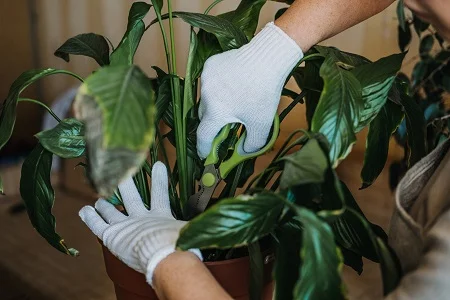10 Plant Disease You Need to Know and Defend Against

Welcome, green enthusiasts! In the vibrant world of gardening, there’s a silent battle happening beneath the soil and among the leaves. Join us as we unveil the secrets of 10 plant diseases that might be plotting against your garden’s well-being. It’s time to become the hero your green companions need – let’s dive into the ultimate guide on defending your garden for a thriving haven!
What Are Plant Diseases?
Plant diseases are like unwanted guests in your garden, disrupting the peace silently. These issues often arise without warning, affecting the health and growth of your green friends. Fungi, bacteria, viruses, and environmental conditions play the role of invisible culprits infiltrating your garden space. Detecting these plant diseases requires a watchful eye – be on the lookout for changes like altered leaf colors, spots, wilting, or unusual growth patterns. Now, armed with knowledge, you step into the shoes of a garden guardian. You play a crucial role in protecting your plants by implementing preventive measures such as proper care, strategic placement, and early detection. In this intricate dance between your green companions and unseen adversaries, your role is pivotal. It’s like being the superhero your garden needs to thrive and flourish.
The Power of Knowing Plant Diseases! 
Embark on a journey into the heart of gardening wisdom – understanding and conquering plant diseases. Let’s unravel the secrets that make proactive knowledge your garden’s greatest ally.
Become the guardian your garden deserves by proactively identifying and addressing plant diseases. It’s not just about reacting to problems; it’s about staying one step ahead to nurture a thriving green haven.
Discover the magic of early detection – your garden’s superpower! Showcase the incredible benefits that come with spotting plant diseases in their infancy. From preserving plant health to ensuring a vibrant landscape, early detection sets the stage for gardening success.
Highlight the tangible advantages of being in the know. From preventing widespread infections to minimizing the use of harsh treatments, understanding plant diseases enhances your gardening experience. Unveil the wisdom that transforms your garden into a flourishing masterpiece.
This isn’t just about plants; it’s about your gardening prowess. Embrace the power of knowledge, be the hero your garden needs, and let the wisdom of understanding plant diseases pave the way for a lush, thriving paradise.
10 Common Diseases and Their Solutions
Causes: Fungal infection thrives in warm and humid conditions.
Solutions:
- Apply fungicides early in the season as a preventive measure.
- Ensure proper spacing between plants for adequate air circulation.
- Remove and destroy infected plant material promptly.
Causes: Cool and moist conditions favor the growth of downy mildew.
Solutions:
- Use resistant plant varieties.
- Apply fungicides preventively.
- Water plants at the base to avoid wetting foliage.
Causes: Soil-borne fungus affecting roots and stems.
Solutions:
- Plant disease-resistant varieties.
- Practice crop rotation to reduce soil pathogen load.
- Ensure well-draining soil to prevent waterlogged conditions.
Causes: Bacterial or fungal infections due to splashing water.
Solutions:
- Water plants at the base to minimize splashing.
- Apply copper-based fungicides.
- Remove and dispose of infected leaves.
Causes: Fungal infection, common in roses, due to high humidity.
Solutions:
- Plant-resistant rose varieties.
- Prune for better air circulation.
- Apply fungicides early in the growing season.
- Canker:
Causes: Fungal or bacterial infections causing lesions on stems.
Solutions:
- Prune infected branches well below the canker.
- Apply fungicides for fungal cankers.
- Practice good sanitation to prevent the spread.
- Anthracnose:
Causes: Fungal infection affecting leaves, stems, and fruit.
Solutions:
- Apply fungicides during the growing season.
- Prune to improve air circulation.
- Remove and destroy infected plant material.
- Mosaic Virus:
Causes: Viral infection transmitted by pests or contaminated tools.
Solutions:
- Control insect vectors.
- Remove and destroy infected plants.
- Practice strict hygiene to avoid tool contamination.
- Wilt:
Causes: Bacterial or fungal pathogens disrupting water transport.
Solutions:
- Plant disease-resistant varieties.
- Improve soil drainage.
- Apply appropriate fungicides or bactericides.
- Apple Scab:
Causes: Fungal infection affecting apple trees.
Solutions:
- Apply fungicides during the growing season.
- Prune for better air circulation.
- Rake and destroy fallen leaves.
Understanding the specific causes and implementing targeted solutions is crucial for effective plant disease management. Regular monitoring, early detection, and prompt action are key elements in maintaining a healthy garden.
Common Plant Diseases Caused by Bacteria
In the diverse and vibrant world of plants, bacterial infections can pose a threat to their well-being, causing a range of diseases. These ailments, often invisible to the naked eye, can manifest in various forms, affecting leaves, stems, and overall plant health. Let’s explore some common plant diseases caused by bacteria.
- Bacterial Blight:
- Commonly affects crops like rice.
- Characterized by water-soaked lesions on leaves.
- Presence of a slimy, ooze-like substance.
- This can lead to significant yield losses if not managed.
- Fire Blight:
- Affects fruit trees, especially apples and pears.
- Causes wilting, blackening, and a burnt appearance.
- Considerable impact on affected areas, resembling fire aftermath.
- Bacterial Canker:
- Affects tomatoes in vegetable gardens.
- Causes sunken lesions on stems and fruits.
- Adversely impacts the overall vigor of the plant.
- Bacterial Spot:
- Caused by Xanthomonas campestris.
- Affects peppers and tomatoes.
- Results in dark, water-soaked spots on leaves.
- Impacts the plant’s ability to photosynthesize.
- Soft Rot:
- Caused by the bacterium Erwinia.
- Common in root vegetables like potatoes and carrots.
- Results in foul-smelling decay.
- This leads to a mushy consistency in affected areas.
- Bacterial Leaf Spot:
- Involves a variety of ornamental plants.
- Causes circular, water-soaked lesions on leaves.
- Can compromise the aesthetic appeal of ornamentals.
Prevention and control strategies for bacterial diseases involve maintaining good plant hygiene, providing proper air circulation, and using resistant plant varieties when available. Timely removal and disposal of infected plant material, coupled with the application of copper-based sprays, are standard practices to mitigate the impact of bacterial diseases on plants. Understanding these bacterial threats equips gardeners with the knowledge needed to foster a healthier and more resilient garden.
Plant Disease Identification and Prevention 
Empower yourself with the skills to identify plant diseases before they strike. Your garden’s resilience starts with you, and it’s time to build your arsenal against potential threats.
Spot the Sneaky Signs:
Become a vigilant guardian by learning the telltale signs of plant diseases. From subtle discolorations to unusual wilting, your keen observation will be the first line of defense.
Active Vigilance, Active Defense:
Don’t just watch – act! Implement preventive measures with the precision of a seasoned guardian. Proper plant care becomes your shield, and strategic placement is your strategic advantage.
Strategic Plant Care:
Nourish your plants with care, keeping them strong and resistant. Prune wisely, water strategically, and provide the nutrients they need to stand tall against invaders.
Tactical Placement:
Position your green allies strategically. Group plants wisely, considering their compatibility and susceptibility to diseases. It’s not just about where they stand; it’s about where they thrive.
A Resilient Haven:
Your garden is more than just plants; it’s a haven of resilience. Equip yourself with knowledge, implement preventive strategies, and let your garden stand as a testament to your active guardianship.
Start Today, Guard Always:
Don’t wait for threats to emerge – be proactive! Start today armed with knowledge and a toolkit of preventive measures. Your garden deserves to flourish, and you’re the guardian it needs.
The Bottom Line
As we wrap up this journey with EcoIndoorGardening through the realm of plant diseases, remember that you’re not just a gardener; you’re a guardian. Armed with knowledge about these sneaky invaders, you now possess the wisdom to protect your green haven. Stay vigilant, be proactive, and watch your garden flourish into the vibrant paradise it was meant to be. Happy gardening, guardian of the green!
















